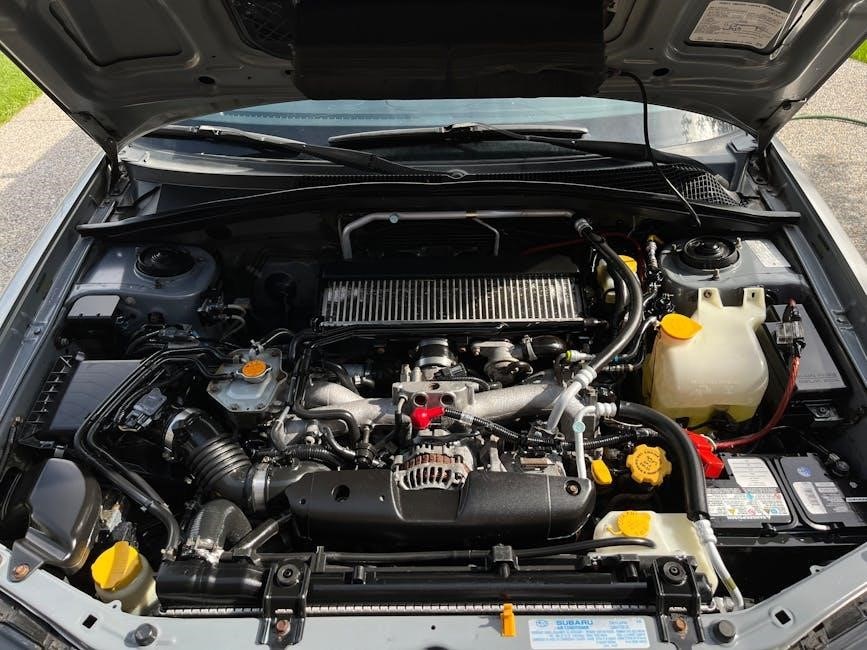The Cub Cadet ZT1 transmission belt diagram is an essential guide for maintaining and troubleshooting your mower’s transmission system. It provides detailed instructions and visuals to ensure proper belt installation and system functionality, helping you keep your mower running smoothly and efficiently.
1.1 Importance of the Transmission Belt Diagram for Maintenance
The transmission belt diagram is crucial for maintaining the Cub Cadet ZT1’s performance. It provides a clear visual guide for understanding belt routing, ensuring proper installation, and diagnosing issues. Regular maintenance requires accurate belt alignment to prevent damage and ensure smooth operation. The diagram helps users identify worn or damaged belts early, avoiding costly repairs. It also serves as a reference for DIY repairs, empowering owners to maintain their mower effectively and extend its lifespan. This resource is essential for keeping the transmission system functioning optimally.
1.2 Overview of the Cub Cadet ZT1 Model and Its Transmission System
The Cub Cadet ZT1 is a high-performance zero-turn mower designed for efficiency and durability. Its transmission system is integral to its operation, ensuring smooth power delivery to the wheels. The belt-driven system is designed for reliability, with components like the transmission belt playing a critical role in maintaining mower functionality. Understanding the ZT1’s transmission setup is key to proper maintenance and troubleshooting, making it essential for owners to familiarize themselves with its mechanics and components to ensure optimal performance and longevity of the mower.

Locating the Cub Cadet ZT1 Transmission Belt Diagram PDF
The Cub Cadet ZT1 transmission belt diagram PDF is available for download from official sources, providing detailed guidance for maintenance and repair of the mower’s transmission system.
2.1 Official Sources for Downloading the Diagram
The Cub Cadet ZT1 transmission belt diagram PDF can be downloaded from the official Cub Cadet website or through authorized dealers. Visit the Cub Cadet official site, navigate to the support or parts section, and enter your model number to access the diagram. Additionally, the operator’s manual, available online, often includes detailed diagrams. Ensure you download from trusted sources to avoid incorrect or incomplete information, as accurate diagrams are crucial for proper belt routing and system maintenance.
2.2 Using Parts Diagram Tools for Accurate Belt Routing
Parts diagram tools are invaluable for ensuring accurate belt routing on the Cub Cadet ZT1. These tools allow you to select your specific model and year, providing a detailed visual breakdown of the transmission system. By referencing these diagrams, you can identify the correct belt path and ensure proper installation. Many parts diagram tools are free to use and available on the Cub Cadet website or through authorized dealers. They simplify the process, reducing the risk of errors and ensuring your mower operates at peak performance. Use these tools to avoid confusion and achieve precise belt routing every time.
Understanding the Transmission Belt Routing
The transmission belt routing diagram provides a clear visual guide for installing and maintaining the belt system on your Cub Cadet ZT1. It ensures proper alignment and functionality, crucial for optimal mower performance and longevity.
3.1 Detailed Belt Routing Explanation
The Cub Cadet ZT1 transmission belt diagram provides a comprehensive visual guide for routing the belt correctly. It illustrates how the belt interacts with pulleys, tensioners, and other components. Proper routing ensures smooth power transmission, preventing slippage or damage. The diagram highlights key points, such as alignment marks and tension adjustment locations, to facilitate accurate installation. By following the diagram, users can ensure the belt is securely fitted, maintaining optimal mower performance and longevity. Always consult the diagram before starting any belt-related maintenance or replacement to avoid errors.
3.2 Common Mistakes to Avoid During Belt Installation
When installing the transmission belt, avoid common errors such as incorrect routing, insufficient tension, or misalignment with pulleys. Ensure the belt is properly seated and aligned to prevent slippage. Over-tightening or under-tightening the belt can lead to premature wear or damage. Always refer to the Cub Cadet ZT1 transmission belt diagram to confirm the correct routing and tension specifications. Failure to follow the diagram may result in poor performance or component failure. Proper installation ensures smooth operation and extends the life of the belt and transmission system.
Step-by-Step Guide to Replacing the Transmission Belt
Start by disengaging the PTO and removing necessary components. Use the Cub Cadet ZT1 transmission belt diagram to ensure correct routing and proper tension for optimal performance.
4.1 Tools and Materials Required for Replacement
To replace the transmission belt on your Cub Cadet ZT1, you’ll need a socket wrench, torque wrench, gloves, safety glasses, and a new belt. Ensure you have the correct belt size and type by referencing the transmission belt diagram. Additional materials like a belt tension gauge and lubricant may be necessary. Always use genuine Cub Cadet parts for optimal performance. Consult the operator’s manual or parts lookup tool for specific tool requirements and to verify the correct belt part number before starting the replacement process.
4.2 Safety Precautions Before Starting the Replacement
Before replacing the transmission belt, ensure the mower is on a level surface and engage the parking brake. Disconnect the battery to prevent accidental start-ups. Wear protective gloves and safety glasses to avoid injury from moving parts. Remove keys and ensure all controls are in neutral. Never work under the mower without proper support. Keep loose clothing tied back and avoid long jewelry that could get caught. Refer to the operator’s manual for specific safety guidelines tailored to the Cub Cadet ZT1 model.

Troubleshooting Common Transmission Belt Issues
Identify symptoms like unusual noise, reduced performance, or belt slippage. Use the transmission belt diagram to diagnose and address issues effectively, ensuring proper mower functionality and longevity.
5.1 Symptoms of a Worn or Damaged Transmission Belt
A worn or damaged transmission belt can cause symptoms such as unusual noise, reduced mower performance, or complete system failure. Look for signs like belt slippage, fraying, or cracks. If ignored, these issues can lead to further damage to the transmission system. Regular inspections using the transmission belt diagram can help identify these problems early, ensuring timely repairs and maintaining optimal mower functionality. Addressing these symptoms promptly prevents costly repairs and extends the belt’s lifespan.
5.2 How to Diagnose and Fix Belt Slippage
Belt slippage can be diagnosed by observing symptoms like inconsistent speed, overheating, or a burning smell. Check the transmission belt diagram to ensure proper routing and alignment. Inspect the belt for wear and tension. To fix slippage, adjust the tension according to the manufacturer’s guidelines using the tools specified in the Cub Cadet ZT1 PDF manual. If the belt is damaged, replace it with a genuine part. Proper maintenance and regular checks can prevent future slippage, ensuring smooth operation of your mower.
Maintenance Tips for Extending Transmission Belt Life
Regular inspections and cleaning ensure optimal performance. Check and adjust belt tension as shown in the Cub Cadet ZT1 transmission belt diagram to maximize belt life and performance.
6.1 Regular Inspections and Cleaning
Regular inspections are crucial for extending the life of the transmission belt. Use the Cub Cadet ZT1 transmission belt diagram to locate and examine the belt for signs of wear, such as cracks or fraying. Clean the pulleys and surrounding areas to prevent debris buildup, which can cause premature wear. Ensure the belt is properly aligned and seated to avoid misalignment issues. By following these steps, you can maintain optimal performance and prevent unexpected breakdowns.
6.2 Proper Belt Tension Adjustment
Proper belt tension is essential for optimal performance and longevity. Refer to the Cub Cadet ZT1 transmission belt diagram to ensure accurate adjustment. Use a torque wrench to tighten the belt according to the manufacturer’s specifications. Check the tension periodically, as improper adjustment can lead to premature wear or belt slippage. Avoid over-tightening, as this may damage the pulleys or bearings. Maintain a balanced tension to ensure smooth operation and prevent unnecessary stress on the transmission system.

Additional Resources for Cub Cadet ZT1 Owners
Access the operator’s manual for comprehensive guidance. Explore online forums and communities for troubleshooting tips and advice from experienced Cub Cadet ZT1 owners and experts.
7.1 Accessing the Operator’s Manual for Further Guidance
The operator’s manual for the Cub Cadet ZT1 provides detailed instructions for maintenance, troubleshooting, and repair. It can be downloaded for free from the official Cub Cadet website by entering your mower’s model number. This resource is essential for understanding the transmission system and ensuring proper belt installation. Additionally, it includes safety guidelines and warranty information. For owners who prefer hard copies, the manual can also be purchased from authorized dealers. Referencing the manual regularly helps maintain your mower’s performance and longevity.
7.2 Online Communities and Forums for Support
Online communities and forums are invaluable resources for Cub Cadet ZT1 owners seeking support. Platforms like Reddit, official Cub Cadet forums, and specialty lawn care groups offer troubleshooting tips, repair advice, and real-world experiences. Users often share detailed solutions for issues like belt slippage or installation challenges. These communities are particularly helpful for diagnosing problems and finding alternative solutions when official guides are unclear. Engaging with fellow mower owners can also provide reassurance and practical insights, ensuring your transmission belt issues are resolved efficiently.
